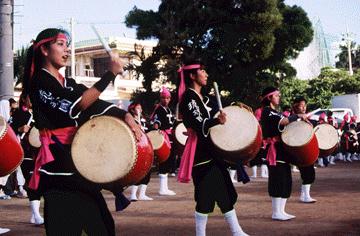|
Obon
"We live in the light of [our ancestors'] contributions. Obon is consequently a time for recognizing our responsibility to life and not merely the marking of death and separation."
Dr. Alfred Bloom, Emeritus Professor, University of Hawaii
|
Obon, is a Japanese Buddhist custom to honor the departed (deceased) spirits of one's ancestors. The custom has evolved into a family reunion holiday during which people return to ancestral family places and visit and clean their ancestors' graves. It has existed in Japan for more than 500 years and traditionally includes a dance, known as Bon-Odori.
[1]
Bon Odori originates from the story of Mokuren, a disciple of the Buddha, who used his supernatural powers to look upon his deceased mother. He discovered she had fallen into the Realm of Hungry Ghosts and was suffering.
Greatly disturbed, he went to the Buddha and asked how he could release his mother from this realm. Buddha instructed him to make offerings to the the many priests who had just completed their summer retreat, on the fifteenth day of the seventh month. The disciple did this and, thus, saw his mother's release.
He also began to see the true nature of her past unselfishness and the many sacrifices that she had made for him. The disciple, happy because of his mother's release and grateful for his mother's kindness, danced with joy. From this dance of joy comes Bon Odori or "Bon Dance", a time in which ancestors and their sacrifices are remembered and appreciated. [2]
|
Another telling:
Moggallana, one of the brilliant disciples of the Buddha, was very devoted to his mother. His mother had died early and Moggallana had been apprehensive of where she had gone after her death. After his attainment [of enlightenment], he searched for her whereabouts with his extrasensory power of clairvoyance, and found her in the World of Hungry Devils (Preta) painfully emaciated as the result of her being miserly in her previous life.
Astounded and saddened by the discovery, Moggallana attempted to relieve her pains by taking her some food in a bowl. But no sooner had the mother touched the bowl, the food fumed into amass of flames. Unable to bear the sight of his mother's pitiful plight, Moggallana went to the Buddha for instructions on how to save her.
The Buddha said: "The evil deeds that your mother committed are so grave that it is beyond your power to extricate her from her state. Fortunately, however, tomorrow is the last day of Vassal If you should give offerings to one thousand monks, they would gladly accept your offerings. The effect of your pious offerings to the monks who have done pure deeds will be great, indeed. By the merit of your virtuous deed, your mother will be relieved from the pains of Preta."
Moggallana followed the Buddha's instruction; and the mother was immediately freed from the sufferings of Preta. [3]
|
